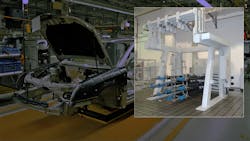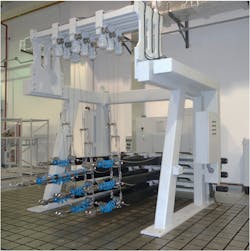This article appeared in Machine Design and has been published here with permission.
Automotive test engineers need tools for a wide variety of fatigue and strength tests. For automotive manufacturers, reducing the cost of testing is always a benefit. For test lab managers, ensuring tests equipment is constantly being used leads to more profitable operations. And for tier suppliers, reducing (or eliminating) unplanned downtime and maintenance helps to meet OEMs’ schedules.
Hydraulic test devices have been the platform of choice for a wide array of automotive testing. In recent years, however, electric test devices have become advanced enough to compete with their hydraulic counterparts.
Unplanned Maintenance
More and more auto test engineers are moving away from the complex infrastructure, higher maintenance and risk of leaks posed by hydraulic test devices. Whether these engineers are upgrading technology or expanding operations, they are weighing several factors such as the routines associated with hydraulics and concerns about safety.
Some test labs and automakers note that younger workers can be unfamiliar with the challenges posed by hydraulics and the maintenance they require. Some workers lack practical experience with hydraulic systems. This unfamiliarity can extend downtime.
Test managers want to know their test devices systems will reliably place a cyclical load or on a specimen.
The Volkswagen plant in Shanghai recently began questioning the cost of its aging hydraulic test equipment, which has constantly required increased maintenance on a complex cooling tower, filters, seals and dedicated pumps. At Shanghai VW, test engineers used hydraulic tests for checking the strength of seat assemblies.
Going Electric
After using the electric multi-axis test system (EMATS), VW compared its test results to those from the company’s legacy hydraulic machinery and found the electric version had a smoother feedback curve—specifically higher positional feedback accuracy of ±0.05 mm (0.002 in) versus the hydraulic system’s ±1.00 mm (0.04 in).
EMATS is a plug-and-play technology platform that requires no hydraulic oil and consumes energy only when a lab runs a test. This makes it less costly and cleaner to operate than hydraulic systems. With EMATS in place, Shanghai VW has leak-free electric actuators with servo motors that deliver better motion-control performance over similarly sized, slower-responding hydraulic designs.
With a typical lifespan of more than 10 years, the total cost of owning EMATS is less than the cost to run the legacy hydraulic system. With hydraulic test devices, managers must constantly run a pump and chiller to cool hydraulic oil.
EMATS only draws power when a lab manager conducts fatigue testing on a seat back, control arm or other auto components; and EMATS draws this power at a much lower rate. By comparison, electric simulation and test equipment developed for the aviation industry use 80% less energy than comparable hydraulic platforms.
Along with reliability, lab managers want flexibility to maintain test schedules and maximize profitability. Consider the effort needed to set up a seat back test with a hydraulic rig. A lab manager would need actuators pushing on the front of the seat, but then need to reconfigure these or other actuators for the sides and seatback. With the typical hydraulic system, test engineers will configure and rotate equipment, plus disconnect and move hoses that can drip hydraulic fluid on test specimens.
At Shanghai VW, EMATS lets managers run component tests by setting up a movable frame with a real-time controller, sealed servomotors and actuators—all in a space of less than 5 cubic meters. To reconfigure the electric actuators, managers simply unplug them and move them to new positions against the test specimen, a process typically accomplished in two or three hours. EMAT’s built-in encoder lets test engineers have precise position control or operate a test by switching the control force repeatably from very small to large loads.
EMARs and similar devices provide an alternative to traditional hydraulic or pneumatic actuation and include one or several electro-mechanical actuators with a matched motor drive control cabinet and a real-time test controller.
If a company is building a new facility and must supply the pump and infrastructure, going with EMATS or another electric machine is less expensive. If a lab or test facility already has the hydraulic infrastructure, then using EMATS will see a payback for the electric system. That’s because managers will only use electricity when a test requires it. That’s the payback.
Craig Lukomski is the solutions commercialization manager for Simulation and Test at Moog.

